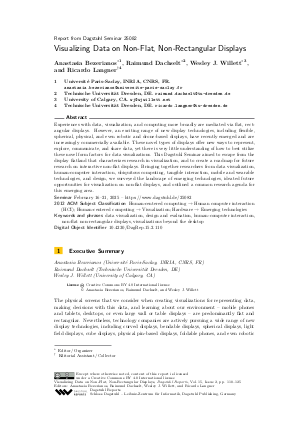Visualizing Data on Non-Flat, Non-Rectangular Displays (Dagstuhl Seminar 25082)
Authors Anastasia Bezerianos, Raimund Dachselt, Wesley J. Willett, Ricardo Langner and all authors of the abstracts in this report
-
Part of:
Issue:
Dagstuhl Reports, Volume 15, Issue 2
Part of: Volume: Dagstuhl Reports, Volume 15
Part of: Journal: Dagstuhl Reports (DagRep) - License:
 Creative Commons Attribution 4.0 International license
Creative Commons Attribution 4.0 International license
- Publication Date: 2025-10-06
File

PDF
DagRep.15.2.110.pdf
- Filesize: 7.74 MB
- 16 pages
Document Identifiers
Subject Classification
ACM Subject Classification
- Human-centered computing → Human computer interaction (HCI)
- Human-centered computing → Visualization
- Hardware → Emerging technologies
Keywords
- data visualization
- design and evaluation
- human-computer interaction
- non-flat non-rectangular displays
- visualizations beyond the desktop
Metrics
- Access Statistics
-
Total Accesses (updated on a weekly basis)
0PDF Downloads0Metadata Views
Abstract
Experiences with data, visualization, and computing more broadly are mediated via flat, rectangular displays. However, an exciting range of new display technologies, including flexible, spherical, physical, and even robotic and drone-based displays, have recently emerged and are increasingly commercially available. These novel types of displays offer new ways to represent, explore, communicate, and share data, yet there is very little understanding of how to best utilize these novel form factors for data visualizations. This Dagstuhl Seminar aimed to escape from the display flatland that characterizes research in visualization, and to create a roadmap for future research on interactive non-flat displays. Bringing together researchers from data visualization, human-computer interaction, ubiquitous computing, tangible interaction, mobile and wearable technologies, and design, we surveyed the landscape of emerging technologies, ideated future opportunities for visualization on non-flat displays, and outlined a common research agenda for this emerging area.
Cite As Get BibTex
Anastasia Bezerianos, Raimund Dachselt, Wesley J. Willett, and Ricardo Langner. Visualizing Data on Non-Flat, Non-Rectangular Displays (Dagstuhl Seminar 25082). In Dagstuhl Reports, Volume 15, Issue 2, pp. 110-125, Schloss Dagstuhl – Leibniz-Zentrum für Informatik (2025)
https://doi.org/10.4230/DagRep.15.2.110
BibTex
@Article{bezerianos_et_al:DagRep.15.2.110,
author = {Bezerianos, Anastasia and Dachselt, Raimund and Willett, Wesley J. and Langner, Ricardo},
title = {{Visualizing Data on Non-Flat, Non-Rectangular Displays (Dagstuhl Seminar 25082)}},
pages = {110--125},
journal = {Dagstuhl Reports},
ISSN = {2192-5283},
year = {2025},
volume = {15},
number = {2},
editor = {Bezerianos, Anastasia and Dachselt, Raimund and Willett, Wesley J. and Langner, Ricardo},
publisher = {Schloss Dagstuhl -- Leibniz-Zentrum f{\"u}r Informatik},
address = {Dagstuhl, Germany},
URL = {https://drops.dagstuhl.de/entities/document/10.4230/DagRep.15.2.110},
URN = {urn:nbn:de:0030-drops-230886},
doi = {10.4230/DagRep.15.2.110},
annote = {Keywords: data visualization, design and evaluation, human-computer interaction, non-flat non-rectangular displays, visualizations beyond the desktop}
}
